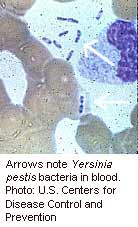
TUESDAY, Jan. 28, 2014 (HealthDay News) — Different strains of the same plague bacterium probably caused two of the most devastating disease outbreaks in human history, according to a new study.
The Justinian plague killed between 30 million and 50 million people — about half the world’s population — in the sixth century as it raged across Europe, Asia, North Africa and the Middle East, according to the study, which was published online Jan. 27 in the journal The Lancet Infectious Diseases.
The Black Death struck about 800 years later, and killed 50 million people in Europe between the years 1347 and 1351 alone.
But while the strain of Yersinia pestis that caused the Justinian plague died out on its own, the strain that caused the Black Death has survived, the researchers said.
They said their findings could lead to a better understanding of modern infectious diseases, including a form of the plague that kills thousands of people a year.
The researchers collected DNA fragments of the Justinian Y. pestis strain from the teeth of two victims who were buried in Germany. They compared this DNA to the genetic material of more than 100 modern strains.
The results showed that the Justinian strain was an evolutionary “dead end” and distinct from strains involved in the Black Death and other later plague pandemics, according to the study.
“The research is both fascinating and perplexing,” said Hendrik Poinar, director of the Ancient DNA Center at McMaster University in Canada.
“It generates new questions that need to be explored. For example, why did this pandemic, which killed somewhere between 50 million and 100 million people, die out?” Poinar, an investigator at the university’s Institute for Infectious Disease Research, said in a university news release.
Another researcher said the findings suggest that a new strain of plague could appear again.
“We know the bacterium Y. pestis has jumped from rodents into humans throughout history, and rodent reservoirs of plague still exist today in many parts of the world,” Dave Wagner, an associate professor at the Center for Microbial Genetics and Genomics at Northern Arizona University, said in the news release. “If the Justinian plague could erupt in the human population, cause a massive pandemic and then die out, it could happen again.”
“Fortunately we now have antibiotics that could be used to effectively treat plague, which lessens the chances of another large-scale human pandemic,” Wagner said.
More information
The U.S. National Institute of Allergy and Infectious Diseases has more about plague.
Copyright © 2025 HealthDay. All rights reserved.

